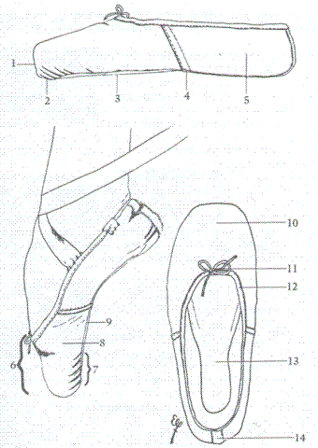|
Ballet Pointe Shoes are Difficult to FitIf you can, purchase two pairs of ballet pointe shoes at a time. Rotate wearing them. The shoes will last longer as the glue in the shoes harden after each time your child wears them in class or rehearsal. Remember when I said pointe shoes are expensive? The investment of buying two pairs is worthwhile, believe me. Let us remember what the shoes must DO Provide correct arch and metatarsal support. Facilitate rolling up and down from pointe. Create a good looking foot. Bulk or "too much shoe" in the Box area does not create a good looking foot. What the shoes must NOT DO Hinder pointe work in any way. Prevent the dancer from standing fully on her toes. Allow high arches to roll right over the box of the shoe. Cause undue pain across the toes. Ask the shoe fitter all the questions you have in mind, while you are in the store. Find out, if you can, if the fitter was a dancer herself and if she wore pointe shoes. If she was or better still, if she is still taking class on pointe, she will be able to answer most of the questions you will ask. Don't forget! You are looking to buy one of the most difficult ballet shoes to fit. They have to be the perfect fitting pointe shoe for you.
Now comes the tricky part. Parents, do not scream, faint or look astonished of what you are about to read and eventually see what is done to the ballet pointe shoe. Especially after paying for the pair, or two pairs. And that is Breaking in new shoes Strange as it may seem, pointe shoes need to be softened (broken in) a bit before your child can wear them. Many ways are used to do this all the way from working the shoes with the hands to smashing them in a door jamb! Use the conservative approach. The two parts to be softened are the Box and the Shank. 1. BOX Using your hands, gently work the Box backwards and forwards until you feel it begins to soften. (Ask your expert shoe fitter to show you how it is done). You can also set the shoes on the floor and step on the Box (gently) once or twice with your bare heel. Your shoe must be removed from your foot before doing this little feat. Then continue working it with your hands and checking every once a while to see that you are not over doing it. 2. SHANK Grasp the shank at the middle with two hands and gently bend it up and down until it gets softer. Have the child try the shoe on to see how far you need to soften the shoe. Do not over do it because you may break the shank, making the shoe useless. The shank needs some softening but not much. After that, as the child works in the ballet pointe shoe for a while the shank will soften more. The above two ways of breaking in new ballet pointe shoes are only a suggestion out of many ways of doing this. Always ask the shoe expert, the ballet teacher, other dancers to find out other ways of breaking in ballet pointe shoes. Fitting ballet pointe shoes can be found on different sites of many dance retailers.
(1) platform of tip (2) edge of pleats or feathers (3) outer sole (4) waist seam (5) quarter or heel section (6)vamp: top of the box that covers the toes (vamp length is the distance between the drawstring knot and the top edge of the box. Some European manufacturers refer to vamp length as the distance between the drawstring knot and the edge of the pleats or feathers) (7) pleats or feather: an area underneath the box where the satin is pleated to fit under the sole (8) wings or supports (9) shank or narrow supporting spine: attatched to the back of the insole (10) stiffened box or block: made of layers of glue and fabric surrounding the toes and ball of the foot (11) drawstring knot (12) drawstring casing: piece of bias tape stitched around the edge of the shoe to contain the drawstring (13) insole (14) back seam: divides the quarters
THIS IS FOR YOU MOMS Have you ever wondered how you can make some extra income without too much of a hassle? Did you ever think that you could do it if you had the time? And if you had the time, would you be willing to try and make some extra income? It would help pay for those ballet pointe shoes your daughter needs when she starts pointe work. Have you ever tried making and/or selling crafts, or setting up home presentations (cosmetics, jewelry, kitchen ware, etc.), or delivering catalogues and products, or similar paid work options. Have you ever tried them and found out that it did not quite work out? Before going on any further, see and hear what a 6 year old girl has to say.
Now that you are back, hit the back button for taking care of those pointe shoes.
|






